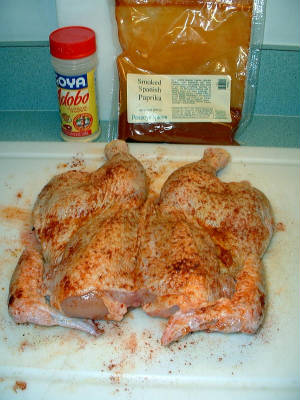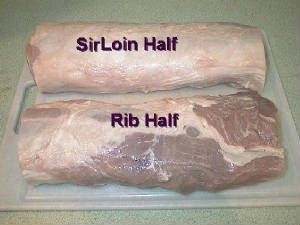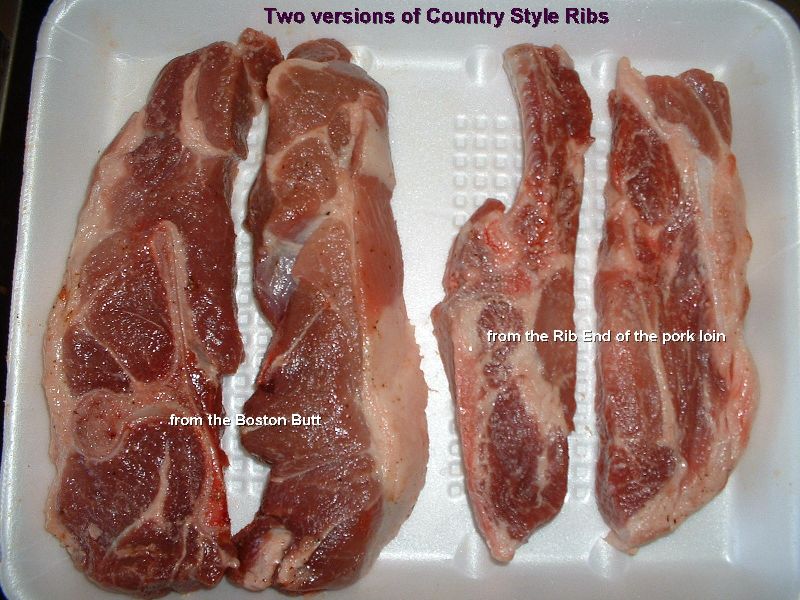|
 |
||||||||||||
|
What is "Spatchcocked" Chicken? Follow this link for a video and a recipe!
"NEW" BBQ book just on the market!! More info here... Question from Julie,"What is a "Texas Grill Steak"? Julie......a "Texas Grill Steak" is a regional term for a big Sirloin Steak, grilled and then sliced thin.
Mostly served over greens in a salad or in a Hoagie Roll with sliced roasted red peppers, baby spinach leaves and a couple
slices of Mozzarella cheese. Question from Rob, "where does a flat iron steak come from? a friend of mine had one the other night at a restaraunt.
I've heard of them but can't remember where they are cut out of?" Answer: The 'flat iron' is cut from the beef chuck shoulder clod 'top blade roast'. The roast is cut down the center
horizontally to remove the connective tissue and then cut into two or four steaks. The meat is very flavorful and relatively
tender. See how to cut your 'own' Flat Iron Steaks here!! Dee, It has to do with oxygen and a scientific word called "myoglobin". When steaks
are first cut they are a deep red, or purple color, and after a few minutes of exposure to oxygen they turn a nice bright
red. This is called "blooming". Over a period of a few days, the myoglobin protein loses it's ability to hold the oxygen and
the meat will turn brown. The same process will turn the inside of hamburger brown, also. On occasion, the myoglobin protein
and exposure to the light will cause steaks to have a "bluish/green" tinge when held to the light at a certain angle. Yes,
the steaks are fine to eat. Also, the steaks are NOT aging, but just getting old. "Would you be able to tell me the difference between Pork Steaks and Pork Chops?" Pork Steaks are cut from the Boston Butt, or Pork Shoulder.Sometimes they are even cut from the fresh ham (hind quarter),
but not often. Pork Chops are cut from the Loin and they may be presented boneless or bone-in. Pork Chops are normally more
tender than the Pork Steaks. Chops can be cooked hot and quick because they are naturally tender, as long as they are not
over cooked. An internal temp of 155° is good. Pork Steaks require a longer cook at a lower temperature to get tender and
are usually done at 185° internal.
Learn how to cut your own Pork Chops!! Click on this link. Can't find what you are looking for? Click here to go to my 'database'. Question from Ed,"I have a brisket flat in the cryopac. How long can I keep it refrigerated past the
"Sell By" date before it goes bad? Thanks." Ed, simple question but a tricky answer. Beef packers do NOT put a sell by date on their meat. That date must've been put
there by the store, on the price label (?), and really means nothing. I'll get back to that in a second, further down. Packers will put a 'packed' date on the box that is shipped to the store. For "BEEF" only, as long as it has been kept
cold, 32-38°, and not jostled around and the cry-o-vac is STILL intact (tight) and in good shape, you can keep beef around
for up to six (6) weeks from the 'pack date'. Sometimes longer, depending on conditions. DrBbq ages his briskets six weeks,
by the way. We are talking 'wet aging' here, not ddry aging. Here is where it gets tricky. The store gets them in and puts them out on display for retail sale. The date on the price
labeling machine is 'usually' set for a few days (3-4) and sometimes up to a week. If the dept manager knows what he's doing
(most don't, sorry), he will put a date on the package of 30 days from the packing date, just to be safe. But, like I said,
not all stores follow this policy. You really, really need to know the "pack date" in order to make an intelligent decision on aging and use of expiration
dates. As long as the one you have is still in good shape (kept cold, juices are not cloudy, the cry-o-vac is not puffy or
broken) then you might be safe to go a week past the date, just to be on the safe side. Sorry I couldn't be more specific.
While on the subject, the 'expiration' dates put on lunch meat, hot dogs, sausages, bacon, etc BY the manufacturer, MUST,
by law, be still edible for up to seven days past the expiration date.
|
|||||||||||||
|
Question from Sophie, "Whenever my husband smokes/BBQs ribs, they come out pretty good, but always seem so fatty. Are we
buying the wrong cut? What should I be looking for and where would be a good place to look for it in SC? He gets so upset
when he cooks and it doesn't turn out EXACTLY the way he wants it to! Sophie, There are several kinds of ribs available to consumers and, yes, they can be confusing. I'll list them here, but
they are NOT in my order of preference, but just as I think of them. Question from Rick, "I am trying to identify a cut of meat called a Denver steak. I am sure of the name as I have
a few in my freezer. I get them when in Michigan on vacation every year, but really hard to find in the south. Can you assist? Denver Steak=This steak is cut from the underblade portion of the beef chuck roll. It's official URMIS name would
be Beef Chuck Underblade Center Cut Boneless. It is cut from the serratus ventralis which is a very highly marbled muscle,
and is of adequate tenderness. Courtesy of Ian Shann at Tyson Foods.
Question from Anita: Are there grades for pork and chicken like there is for beef? Thanks, Anita. Yes and no, please check out the following.............................. Meat Grade Refresher By Steve Graves Most people know the three basic USDA grades of beef, but are somewhat unaware of the rest of the beef, pork, chicken,
and to an extent, lamb and veal grades. The following are the standards of the USDA with a few opinions of my own thrown in. BEEF Prime- the best quality of beef you can get! Has plenty of marbling (flecks of fat in the muscle tissue) and very tasty,
tender. Used to be that Prime was reserved for your better restaurants and hotels, but can now be found in upscale grocery
stores and meat markets. Choice- has less marbling than Prime, but still very high quality. USDA Choice is the grade carried by most supermarkets
and box/discount warehouses. A good high level of Choice beef can be just as good as a lower level of Prime. Why? (see below) ( for an example, you have a cow/steer that is just too good to be considered Select, but there are five cows in line that
are a better Choice, but not quite Prime. So, now we have six cows that fit into the Choice grade with each one having a better
quality than the one before it. Packers will take that higher level of Choice and Prime and market it at a higher price. Iowa
Beef Packers normal retail Choice is from cow #s 3 and 4 and they will market #s 5 and 6 as their own Chairmans Reserve Beef.) Select- a lot leaner than Choice or Prime. Sometimes it may be tender, but as a whole it is not as juicy or flavorful
as the two higher grades. Wal-Mart and Albertsons, among others, feature this grade of beef. It is possible to grill the cuts
from the rib, loin and sirloin, but I recommend marinating first. I personally prefer to avoid Select beef. "No-Roll Beef Standard- has no marbling what so ever. It will be a darker red than the other grades and will have less beef flavor,
if any at all. Not so much now, but quite prevalent a few years ago, Standard grade was the store brand, as in "IGA Brand
Beef". It may also be sold as ungraded or no-roll beef. Commercial, Utility, Cutter and Canner- are older, mature beef and devoid of any marbling and tenderness. This
beef is mostly sold as ground meat and other processed meats (soups, canned meat, TV dinners, etc) PORK Pork is not labeled any grade quality, but is USDA inspected for wholesomeness. Tech-nically, for packers, not consumers,
pork IS graded US1, US2, 3 and 4 and each is determined by the amount of back fat thickness over the last rib. Most pork processed
in the United States today falls in US1 category. When buying, make sure the pork is grayish-pink in color, firm and has some
degree of marbling. POULTRY Chicken- Practically ALL chicken sold at retail level is Grade A. Chicken in this category will be firm, full breasted,
meaty, no blemishes, no broken skin or broken bones. Grades B and C can have any or all of the defects listed above. As a
rule, when supermarkets feature a loss leader item, such as .29 Leg Quarters, etc, they are Grade B or C and the grade label
or may not even be labeled at all. If the word "blem" is mentioned, consider it B or C. Turkey and Ducks- see above LAMB Prime- same as Beef Prime Choice- same as Beef Choice Good, Utility and Cull- these grades are not sold at retail level. VEAL Prime- see Beef Prime Choice- see Beef Choice Good- see Beef Select Standard- see Beef Standard Utility- see Beef Utility Unlike mature animals (beef), veal is lighter in color and will be grayish pink to light pink. The bones may be reddish
in color. What is the difference between "Dry" and "Wet" aged beef? Click here for answer. Click here to see how to properly "Wet Age" a primal cut of beef. |
|||||||||||||
|
|
|||||||||||||
 |
|||||||||||||
|
With the latest increase in SPAM (junk mail) most servers have installed filters for client's emails. IF you have not received an answer to your question within two business days, please resubmit your question with a different subject line. Please note that any off topic or threatening emails will NOT be answered, but will be forwarded to your ISP and appropriate authorities for further action.
|
|||||||||||||


